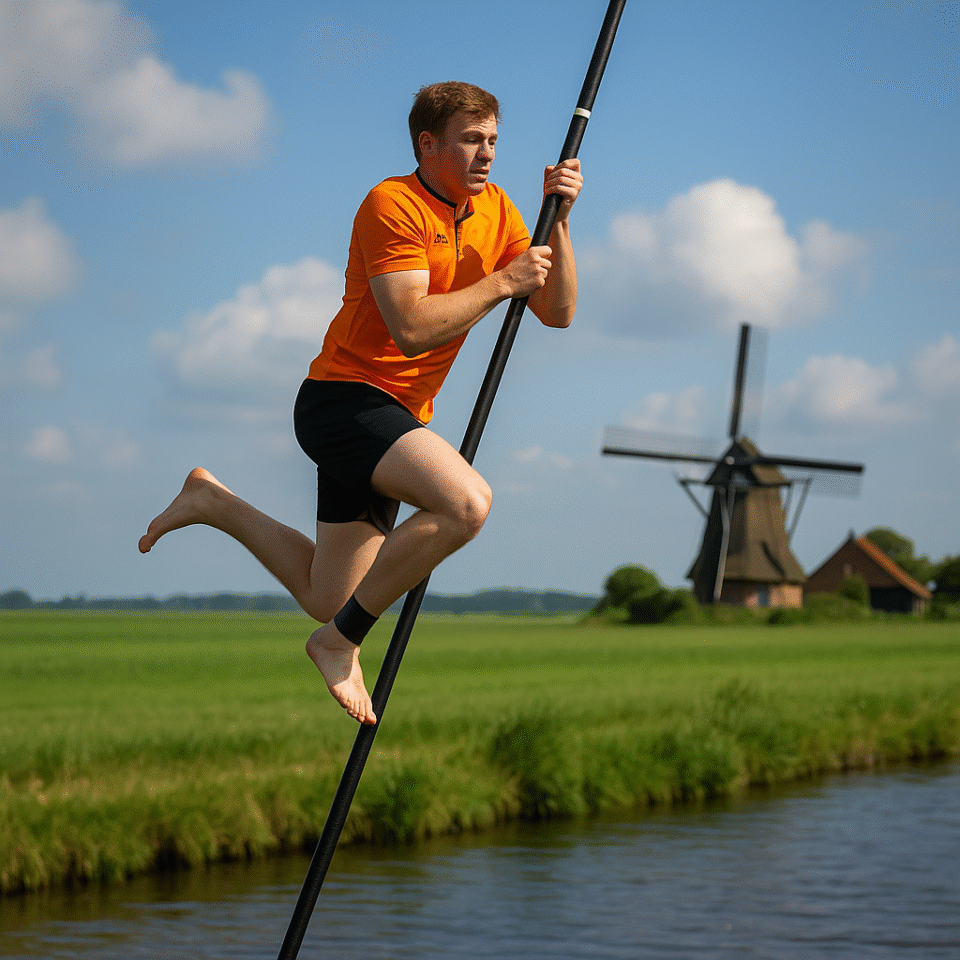7 Dutch Pastimes That Might Confuse the Average American
Moving to the Netherlands as an American means discovering that your new neighbors have some… creative interpretations of what constitutes a sport. From pole vaulting over ditches to basketball with no backboards, Dutch athletics will have you questioning everything you thought you knew about competition.
You know that moment when you’re walking through a Dutch park, minding your own business, and you stumble upon what looks like tennis being played in a glass cage? Or when you flip on the TV and witness people launching themselves over canals with nothing but a really long stick? Welcome to Dutch sports culture, where the phrase “wait, that’s actually a thing?” becomes a regular part of your vocabulary.
As an American expat, I’ve learned that the Netherlands has a delightful way of taking familiar concepts and giving them a uniquely Dutch twist. Sure, we Americans invented basketball and perfected baseball, but the Dutch? They’ve mastered the art of making you question whether you’re watching a legitimate sport or an elaborate prank. Let me introduce you to seven Dutch pastimes that’ll have you scratching your head and possibly Googling “is this real?”
1. Padel: Tennis Had a Baby with Squash
Picture tennis, but shrunk down and trapped in a glass box. That’s padel, and it’s absolutely everywhere in the Netherlands right now. The court is about a third the size of a tennis court, surrounded by glass walls and mesh fencing that you can actually play off of (like squash, but outdoors and with a partner).
The Dutch have embraced padel with the enthusiasm they usually reserve for complaining about train delays. It’s social, it’s active, and it fits perfectly into their love for activities that combine exercise with gezelligheid (that untranslatable Dutch concept of cozy togetherness). You’ll find padel courts popping up in every suburb, and Dutch people will invite you to play with the same casual confidence they’d suggest grabbing coffee.
As an American, your first reaction will probably be confusion, followed by mild frustration when you realize the ball can bounce off walls and you have no idea where it’s going. It’s like someone took tennis and decided it needed more chaos. But stick with it (padel is surprisingly addictive, and it’s become the fastest-growing sport in the Netherlands for good reason).
2. Korfbal: Basketball’s Confusing Dutch Cousin
Imagine trying to explain basketball to someone who’s never seen it before, but you’re really bad at explaining things. The result might look something like korfbal. It’s played on a court divided into zones, with teams of eight players (four men, four women), and instead of a backboard and rim, there’s just a tall pole with a basket on top—no backboard, no rim, just a cylindrical basket that the ball has to drop into from above.
Oh, and you can’t dribble. Or run with the ball. Or guard someone of the opposite gender.
Korfbal was actually invented by a Dutch schoolteacher in 1902 as a way to get boys and girls playing sports together, which explains why it feels like basketball designed by committee. The Dutch take it seriously though—there’s a national league, international competitions, and kids playing it in schools across the country.
Watching korfbal as an American is like watching a familiar movie dubbed in a foreign language. You recognize some elements, but everything feels slightly off. The lack of a backboard alone will have you wondering how anyone ever scores, and yet somehow they do, with a precision that suggests they’ve figured out something about physics that we Americans missed.
3. Fierljeppen: Pole Vaulting Over Ditches (Yes, Really)
This is where Dutch sports get truly, wonderfully weird. Fierljeppen (which roughly translates to “far leaping”) involves running toward a canal or ditch, grabbing onto a really long pole (we’re talking 8-13 meters), climbing up it while it falls across the water, and then launching yourself as far as possible onto the other side.
It originated in Friesland, where farmers needed to cross the numerous ditches and waterways that crisscross the landscape. Instead of building bridges like sensible people, they apparently thought, “You know what? Let’s make this a competition.”
The technique looks like something between pole vaulting and tree climbing, and watching it for the first time will convince you that either the Dutch have a completely different relationship with gravity, or you’re witnessing some sort of elaborate performance art. The current world record holder can clear over 22 meters (that’s 72 feet), which is roughly the distance from home plate to first base in baseball.
As an American watching fierljeppen, you’ll cycle through several emotions: confusion, disbelief, genuine concern for the participants’ safety, and finally, grudging respect. It’s absurd, it’s dangerous, and it’s absolutely, unmistakably Dutch.
4. Speed Skating: Winter Olympics Meet Commuter Culture
Okay, so Americans know speed skating exists (we see it every four years during the Winter Olympics). But in the Netherlands, speed skating isn’t just a sport; it’s practically a religion. The Dutch don’t just dominate international speed skating; they’ve turned it into a cultural phenomenon that bridges professional athletics and everyday life.
When the canals freeze over (which admittedly happens less frequently these days), the entire country seems to strap on skates. The Elfstedentocht (an 11-city skating tour covering 200 kilometers of frozen canals) becomes front-page news when conditions allow. Even when it doesn’t happen for years at a time, the mere possibility keeps the entire nation on edge.
What’ll surprise you as an American is how speed skating technique has influenced regular Dutch ice skating. Go to any ice rink in the Netherlands, and you’ll see kids who can barely walk properly gliding around with perfect speed skating form. It’s like if every American child learned to throw a football with NFL-level technique.
The Dutch approach to speed skating embodies their practical nature: why just skate when you can skate efficiently? It’s transportation, recreation, and national pride all rolled into one smooth, powerful stride.
5. Kaatsen: Cricket’s Distant, Confusing Relative
Kaatsen is a Frisian sport that looks like someone tried to recreate cricket from a half-remembered description. Three players stand in a field, one throws a ball, another hits it with their bare hand (yes, bare hand), and then they all run around trying to score points in a way that makes perfect sense to Frisians and absolutely no sense to anyone else.
The sport dates back centuries and is still played regularly in Friesland, with serious competitions and everything. Players develop callused hands from repeatedly smacking a hard leather ball, and the technique for hitting involves a full-body motion that looks like a cross between a volleyball spike and someone swatting at a really persistent wasp.
Watching kaatsen as an American is an exercise in trying to reverse-engineer the rules from observation alone. Just when you think you’ve figured out the scoring system, someone does something that completely upends your understanding. It’s simultaneously ancient and timeless, local and universal (and completely baffling to outsiders).
6. Bossaball: Volleyball Had Too Much Coffee
Imagine volleyball, but played on a giant inflatable court with trampolines on either side and allowing players to use their feet, head, and hands. Now add some music, a referee who doubles as a DJ, and teams that look like they’re having way too much fun for this to be a serious sport.
That’s bossaball, and yes, it was invented in the Netherlands (though inspired by Brazilian beach culture). It combines elements of volleyball, soccer, gymnastics, and trampolining into something that looks less like a sport and more like what happens when athletes get creative with playground equipment.
The Dutch love bossaball because it embodies their approach to innovation: take something that already works, add some unexpected elements, and see what happens. It’s played on beaches, at festivals, and in gyms, and watching it will make you question why all sports don’t involve trampolines.
As an American, bossaball will trigger your “this can’t be real” reflex, followed quickly by “I want to try this immediately.” It looks like the kind of sport that would be invented by people who think regular volleyball isn’t chaotic enough.
7. Dutch Cycling: When Transportation Becomes Competition
Americans think of cycling as either a recreational activity or something that happens in the Tour de France. The Dutch have turned it into a way of life that occasionally becomes competitive. We’re not just talking about professional cycling (though the Netherlands produces plenty of world-class cyclists), we’re talking about the daily, urban cycling culture that treats every commute like a potential race.
Watch Dutch people navigate Amsterdam traffic on bikes, and you’ll witness athletic feats that would impress Olympic cyclists. They’re carrying groceries, children, furniture, and sometimes other bikes, all while maintaining perfect balance and executing maneuvers that would terrify most Americans.
The competitive aspect isn’t formal (there are no official races during rush hour), but there’s definitely an unspoken understanding that efficiency, speed, and style all matter. Dutch cyclists will pass you while texting, eating, and having a conversation, making it look effortless in a way that suggests supernatural abilities.
For Americans used to treating bicycles as recreational equipment, Dutch cycling culture is both inspiring and intimidating. It’s a reminder that the line between transportation and sport is thinner than we might think.
Embracing the Beautiful Confusion
Living in the Netherlands as an American means accepting that your new home has a wonderfully warped relationship with competition and recreation. These sports—from the gravity-defying fierljeppen to the gloriously chaotic bossaball—reflect something essential about Dutch culture: a willingness to take familiar concepts and make them uniquely their own.
You don’t have to understand korfbal to appreciate the ingenuity behind it, and you certainly don’t need to master padel to enjoy watching your Dutch neighbors become completely obsessed with it. Sometimes being an expat means sitting in the stands, slightly confused but thoroughly entertained, watching people do things you never imagined were possible.
And who knows? You might find yourself drawn into one of these wonderfully weird sports. After all, nothing says “I’m adapting to Dutch culture” quite like learning to pole vault over a ditch or developing calluses from hitting a leather ball with your bare hand. Just don’t expect it to make sense right away—that’s half the fun.








